Alabama is a southeastern state which is home to vast numbers of animals, both large and small. There are 43 species of snakes that call it home, including six that are venomous. Alabama has 60 miles of coastline along the Gulf of Mexico, as well as numerous other wetland habitats. Therefore, you’ll actually find a lot of water snakes in Alabama! In this article, we’ll find out who they are and discover where they live.

1. Northern Cottonmouth (Agkistrodon piscivorus)
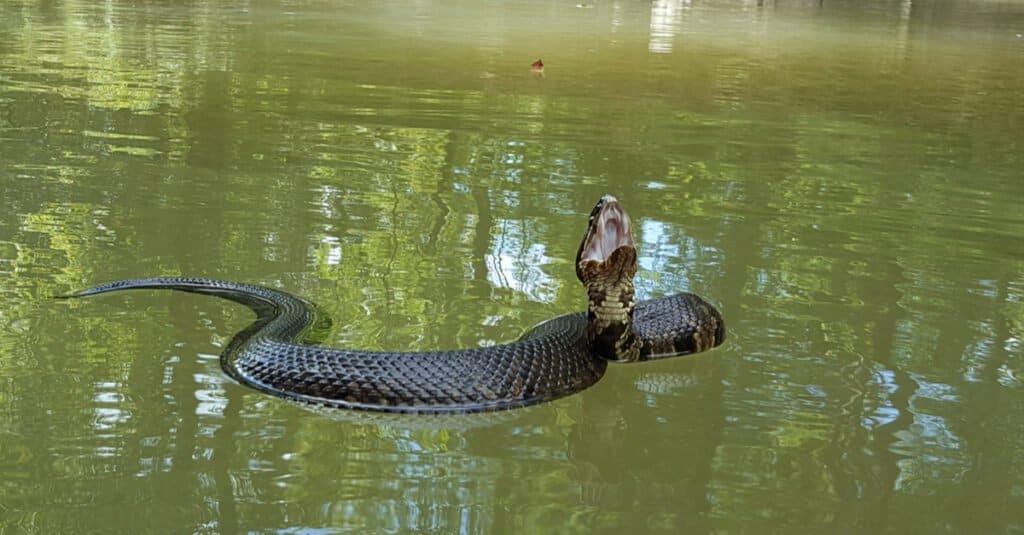
Cottonmouths are the only venomous snake that you’ll encounter in the water in Alabama.
©Seth LaGrange/Shutterstock.com
We’ll kick off the list with the only dangerous snake on the list — the northern cottonmouth. Cottonmouths have a high venom yield and possess cytotoxic venom. This type of venom breaks down tissue and eventually causes tissue death. Although it is rarely fatal this venom can result in the affected limb needing to be amputated. Cottonmouths are 30 to 42 inches long and have brown bodies which are overlaid with dark brown or black crossbands. However, juveniles are a reddish-brown color and have a sulfur-yellow tail tip. Cottonmouths are abundant in Alabama and live in most freshwater habitats.
2. Brown Water Snake (Nerodia taxispilota)
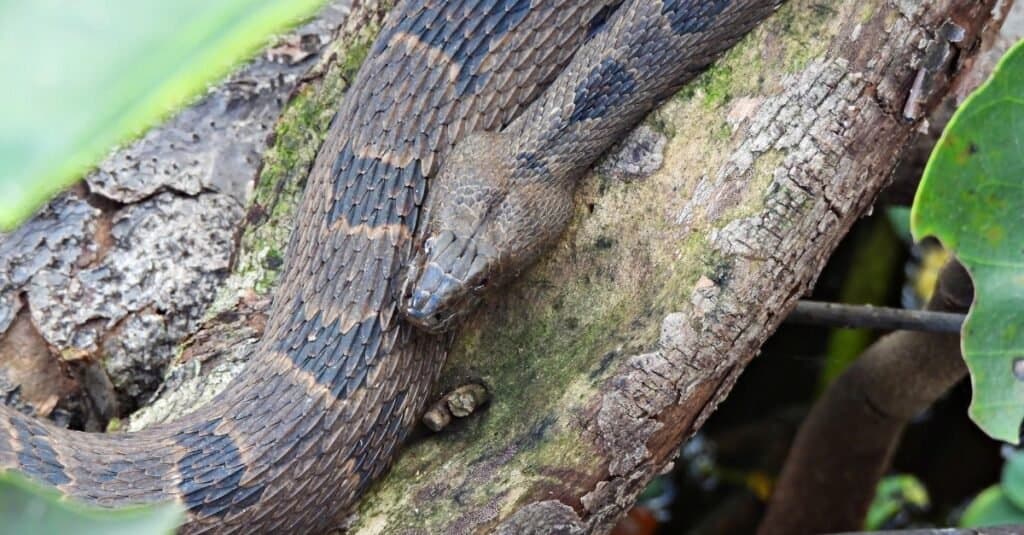
Brown water snakes typically prey on catfish.
©iStock.com/passion4nature
The first true water snake on the list is the brown water snake which inhabits slow-moving rivers and canals in the southeastern region of the Coastal Plain. Brown water snakes are 30 to 60 inches long and are tan with dark brown blotches down the center of their back. Their appearance is similar to the cottonmouth, and as a result, they are often mistaken for them. However, brown water snakes are not venomous and usually flee back into the water when threatened. They prey on freshwater fish, with a preference for catfish.
3. Mud Snake (Farancia abacura)
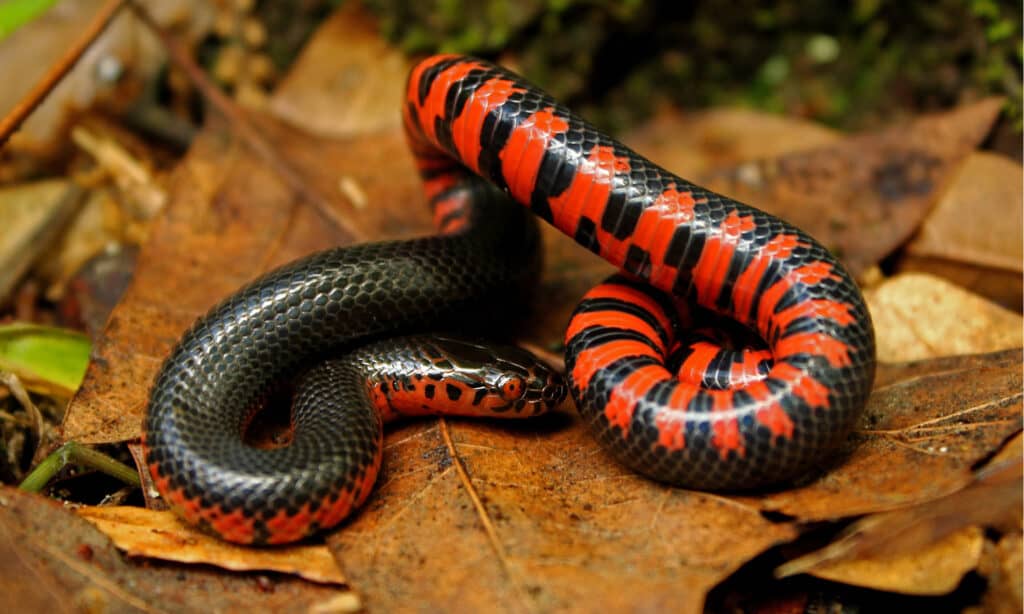
The mud snake has a distinctive appearance with bright red bars on its belly.
©Thesigner_2696/Shutterstock.com
Mud snakes are another large water snake in Alabama, reaching 40 to 54 inches long. They have glossy black bodies with smooth dorsal scales, while their belly has approximately 53 red bars which extend up the sides of their bodies. As suggested by their name, they typically inhabit muddy-bottomed areas, such as swamps, ponds, and slow-moving streams. They are widespread across the Coastal Plain, with both subspecies being present. Mud snakes are nocturnal and prey mainly on giant salamanders.
4. Gulf Salt Marsh Snake (Nerodia clarkii clarkii)
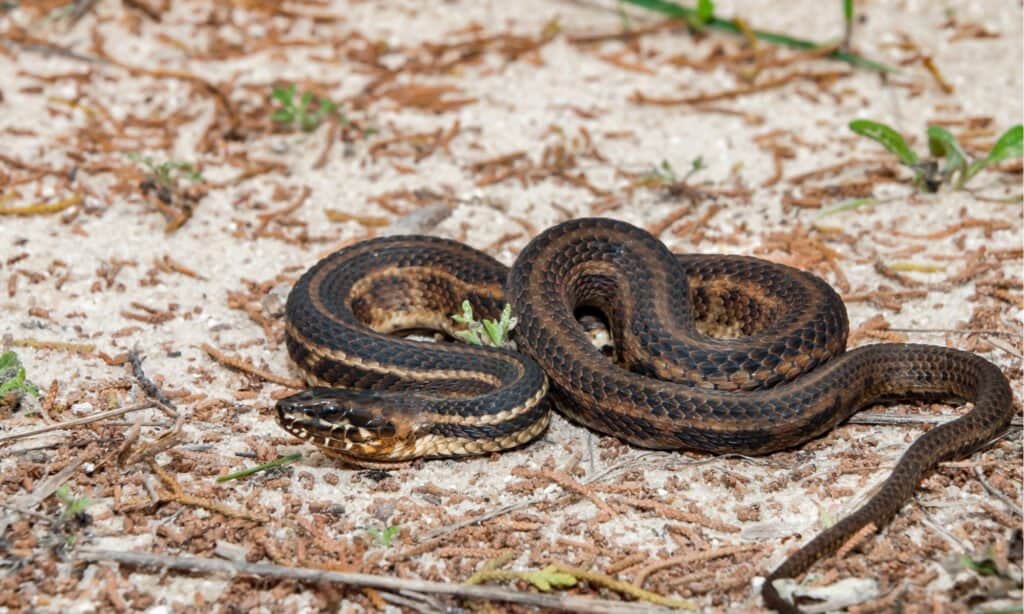
The Gulf saltmarsh water snake can be found along the coastal area in habitats with brackish water
©Jay Ondreicka/Shutterstock.com
Next, we have a subspecies of the salt marsh snake — the Gulf salt marsh snake. As their name suggests, these snakes live in salt marshes and brackish waters around the coast. As they have a limited habitat they are considered to be under threat in Alabama. Gulf salt marsh snakes are relatively small snakes, ranging between only 15 and 30 inches. They are typically dark gray to brown and have four yellowish longitudinal stripes. They also have a dark belly with white spots. Gulf salt marsh snakes are not venomous and do not typically bite. They prey on a variety of fish, crayfish, and shrimp which they catch after they become stuck in pools caused by the tide going out.
5. Southern Water Snake (Nerodia fasciata)
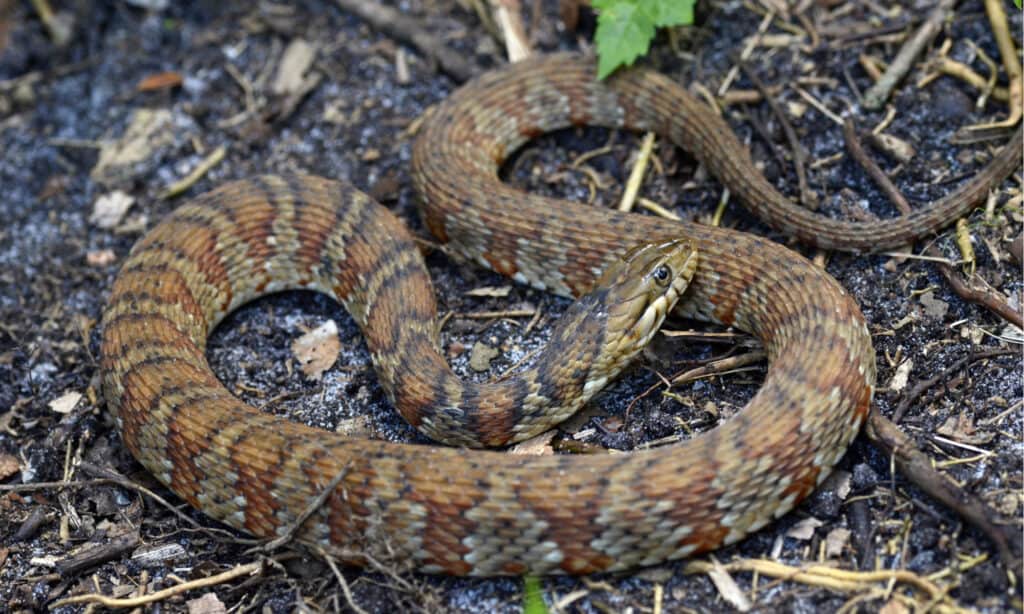
Banded water snakes typically inhabit shallow areas of water.
©Patrick K. Campbell/Shutterstock.com
Also known as the banded water snake, the southern water snake is approximately 22 to 42 inches long. They are dark brown snakes with brown or red crossband markings and light-colored bellies with red spots. Southern water snakes are fairly common across Alabama and inhabit shallow areas of water — such as swamps, ditches, and ponds. They are nocturnal snakes and typically prey on small fish and frogs. Although they are not venomous, they will frequently bite as a means of defense if they are cornered.
6. Plain-Bellied Water Snake (Nerodia erythrogaster)
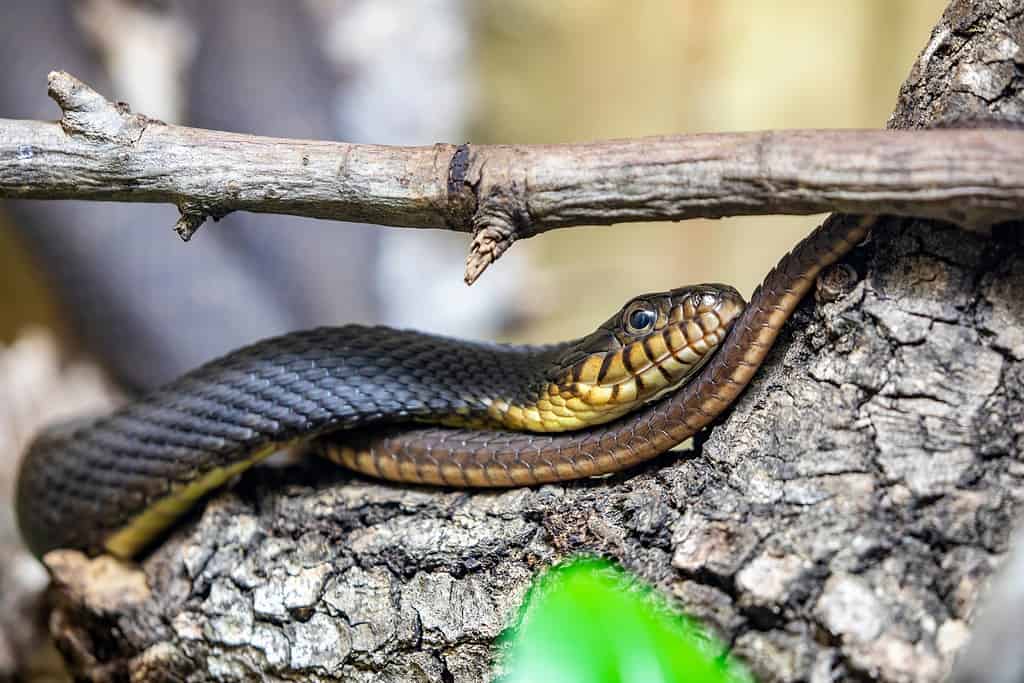
Plain-bellied water snakes are named for their plain, unmarked bellies.
©Danny Ye/Shutterstock.com
One of the most common water snakes in Alabama is the plain-bellied water snake. There are two subspecies that occur in the state — the redbelly water snake and the yellowbelly water snake. The redbelly subspecies occur in the southeastern region, while the yellowbelly subspecies occur throughout the rest of the state. Both subspecies are around 30 to 40 inches long. However, redbelly water snakes are brown on their dorsal side with a red or orange belly, while yellowbelly water snakes are greenish gray with a yellow belly. Both live in large bodies of water such as lakes, rivers, and swamps and prey on a variety of fish, salamanders, and frogs.
7. Midland Water Snake (Nerodia sipedon pleuralis)
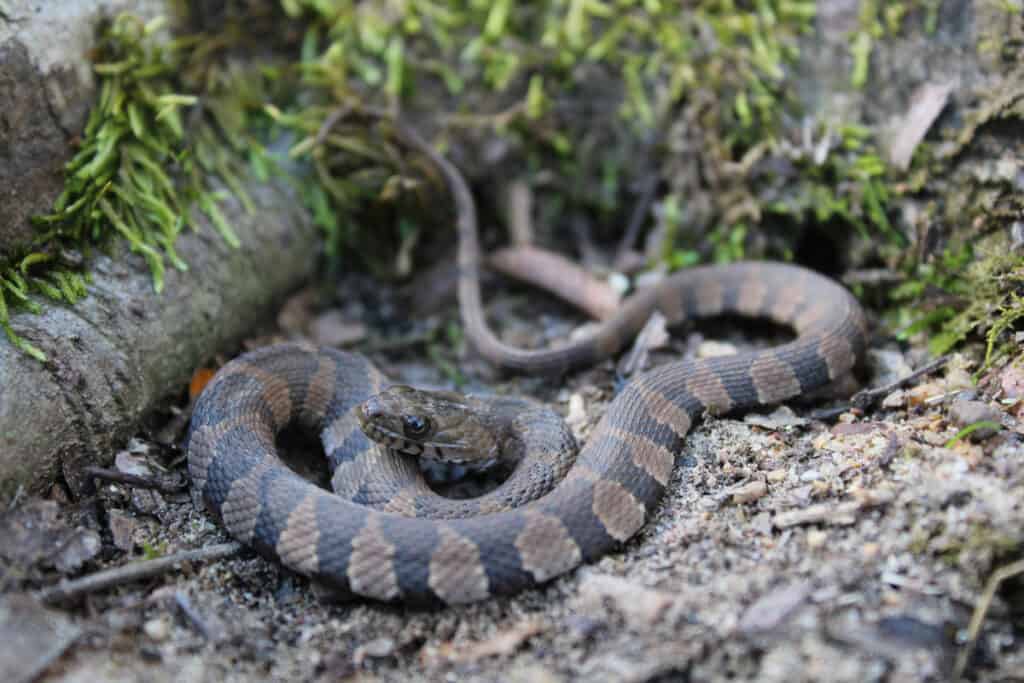
Midland water snakes occur across the majority of Alabama, but they are not as common across the Coastal Plain.
©Tucker Heptinstall/Shutterstock.com
Next, we have the midland water snake. These snakes are one of four subspecies of the northern water snake. Midland water snakes are typically between 24 and 30 inches long and are a light brown ground color overlaid with dark brown crossbands. The crossband markings then transition to blotches as they get further down their body. Midland water snakes are widespread across the majority of Alabama, with the exception of the Coastal Plain where they only occur around the Choctawhatchee, Conecuh, and Yellow rivers. Midland water snakes are not venomous and prey on a variety of fish and amphibians which they swallow alive.
8. Mississippi Green Water Snake (Nerodia cyclopion)

The Mississippi green water snake inhabits slow-moving bodies of water.
©Rusty Dodson/Shutterstock.com
Mississippi green water snakes are harmless snakes that inhabit Baldwin and Mobile counties in Alabama. They typically live in calm, slow-moving waters and are particularly common in forests swamps, oxbow lakes, and streams around the Tensaw River delta. Mississippi green water snakes are large snakes that reach 30 to 45 inches long. They have greenish-brown bodies and either a gray or brown belly with light-colored half-moon markings. They also have a distinctive row of scales between their eyes and lips which can be used to identify them. Mississippi green water snakes breed during April and May and the females give birth to live young between August and September.
9. Queen Snake (Regina septemvittata)
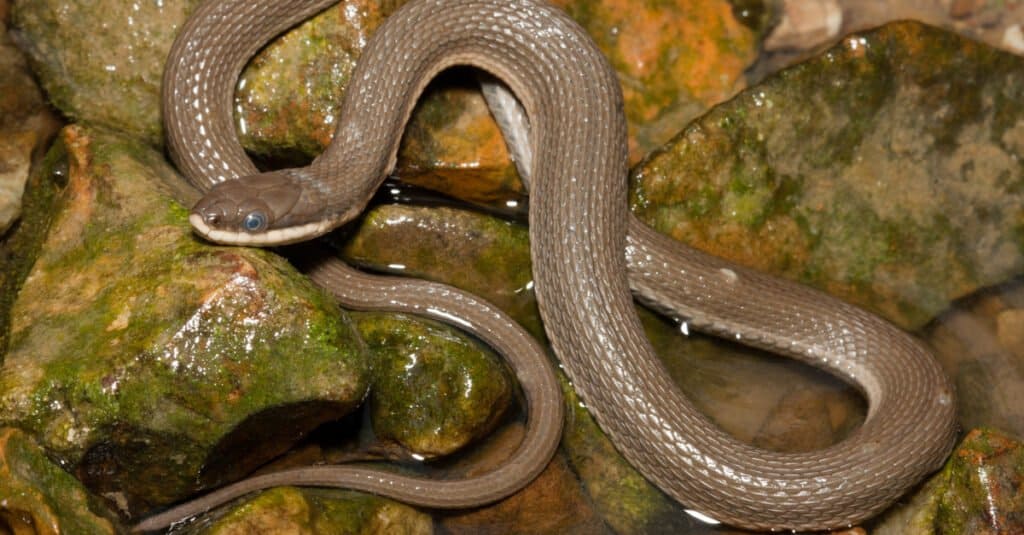
Queen snakes have thick scales and flattened heads to protect them from rocks when they are searching for prey.
©Nathan A Shepard/Shutterstock.com
The next water snake in Alabama is the queen snake which is considered to be a species of moderate conservation concern due to its declining numbers in the southern region of the state. Queen snakes inhabit shallow, rocky-bottomed streams and rivers throughout the state. However, they are absent from areas of the Coastal Plain to the west of the Tombigbee River and from the southern region of Baldwin County. Queen snakes mainly prey on crayfish and they have some unique adaptations to protect them while they are hunting for them. As they often reach between rocks they have a flattened head and wide, thick scales on them. They are approximately 15 to 24 inches long with brown bodies and darker stripes. Additionally, they have yellow bellies with brown stripes.
10. Glossy Crayfish Snake (Liodytes rigida)
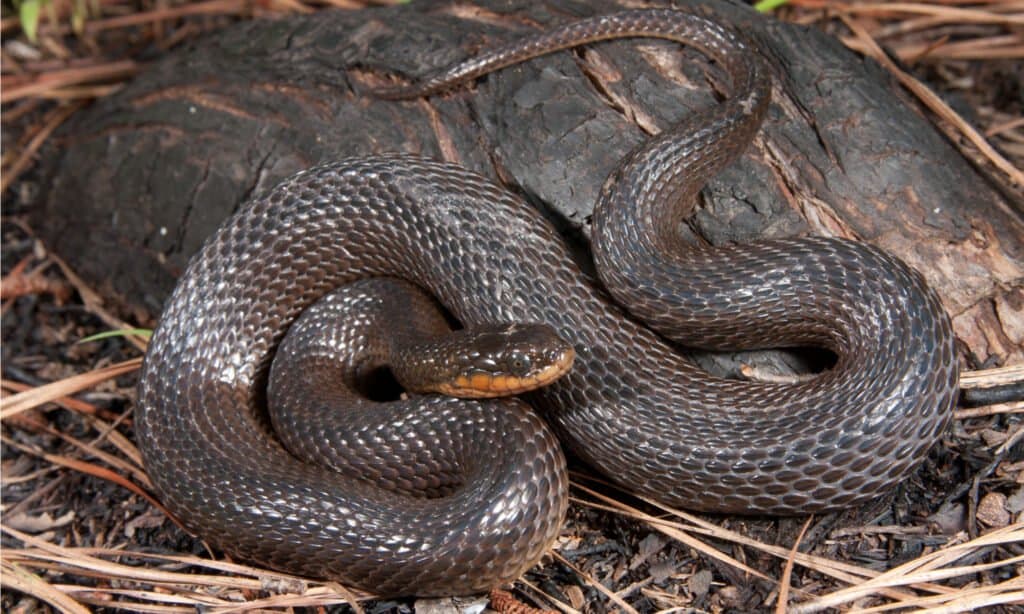
Glossy crayfish snakes prey predominantly on crayfish.
©Nathan A Shepard/Shutterstock.com
The glossy crayfish snake is a relatively small snake at only 14 to 24 inches long. They have brown bodies with shiny scales and several narrow stripes. They also have yellow scales on their lips and yellowish bellies with several darker half-moon markings. Glossy crayfish snakes are found in a variety of wetland habitats across the Coastal Plain, with the exception of the northwestern region. As their name suggests, they feed predominantly on crayfish.
11. Diamond-Backed Water Snake (Nerodia rhombifer)

Diamond-backed water snakes can be identified by their diamond-shaped markings.
©Tucker Heptinstall/Shutterstock.com
Another true water snake is the diamond-backed water snake which inhabits the western region of the state, particularly around the Black Warrior and Tombigbee Rivers. They live in any aquatic habitat — such as lakes, rivers, ponds, swamps, streams, and ditches. Diamond-backed water snakes are large snakes and typically range between three and four feet long, although larger specimens are not unusual. They have a distinctive diamond-shaped pattern on their bodies which is formed by black blotches which are joined by diagonal black lines. Their dorsal side is dark brown with keeled scales, while their bellies are yellow with dark spots.
12. Florida Green Water Snake (Nerodia floridana)
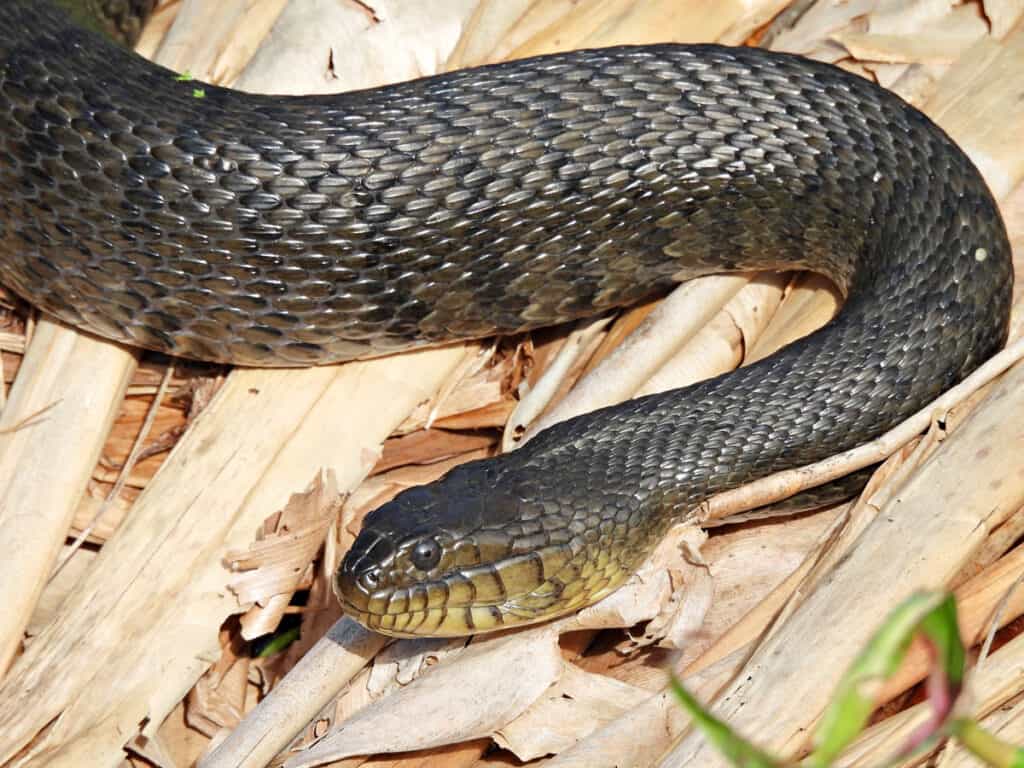
In Alabama, the Florida green water snake can only be found in the Coastal Plain.
©iStock.com/passion4nature
The Florida green water snake is considered to be a species of conservation concern in Alabama as it is only found in the Coastal Plain between Mobile Bay and Baldwin County. They typically inhabit swamps, marshes, and wetland prairies, but prefer areas with thick aquatic vegetation. Florida green water snakes are large snakes and can reach approximately six feet long. They are greenish brown with a lighter-colored belly. They also have one to three small scales between their eyes and lips. Florida green water snakes primarily feed on fish and frogs.
13. Eastern Ribbon Snake (Thamnophis sauritus sauritus)

Eastern ribbon snakes are more active during the night when it is frog breeding season.
©Jay Ondreicka/Shutterstock.com
Lastly, we come to the eastern ribbon snake. Eastern ribbon snakes occur statewide where they inhabit areas close to a permanent source of water — especially areas with plenty of thick vegetation for them to hide in. They prefer to eat frogs, but also prey on fish and insects. They are mainly diurnal snakes but often become active during the night when the frogs are breeding. Eastern ribbon snakes are brown with yellow stripes and can reach 33 inches long.
Summary of 13 Water Snakes in Alabama
| Rank | Water Snake | Scientific Name |
|---|---|---|
| 1 | Northern Cottonmouth | (Agkistrodon piscivorus) |
| 2 | Brown Water Snake | (Nerodia taxispilota) |
| 3 | Mud Snake | (Farancia abacura) |
| 4 | Gulf Salt Marsh Snake | (Nerodia clarkii clarkii) |
| 5 | Southern Water Snake | (Nerodia fasciata) |
| 6 | Plain-Bellied Water Snake | (Nerodia erythrogaster) |
| 7 | Midland Water Snake | (Nerodia sipedon pleuralis) |
| 8 | Mississippi Green Water Snake | (Nerodia cyclopion) |
| 9 | Queen Snake | (Regina septemvittata) |
| 10 | Glossy Crayfish Snake | (Liodytes rigida) |
| 11 | Diamond-Backed Water Snake | (Nerodia rhombifer) |
| 12 | Florida Green Water Snake | (Nerodia floridana) |
| 13 | Eastern Ribbon Snake | (Thamnophis sauritus sauritus) |
The photo featured at the top of this post is © Laurie L. Snidow/Shutterstock.com
Discover the "Monster" Snake 5X Bigger than an Anaconda
Every day A-Z Animals sends out some of the most incredible facts in the world from our free newsletter. Want to discover the 10 most beautiful snakes in the world, a "snake island" where you're never more than 3 feet from danger, or a "monster" snake 5X larger than an anaconda? Then sign up right now and you'll start receiving our daily newsletter absolutely free.
Thank you for reading! Have some feedback for us? Contact the AZ Animals editorial team.






